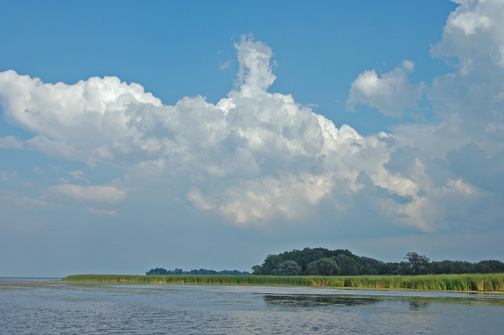Biologists, anglers talk state of Lake Ontario fishing
GORDON BLOCK / WATERTOWN DAILY TIMES
Anglers listen to a presentation on Tuesday night in Pulaski about the status of fishing in Lake Ontario. The DEC said the 2015 had historically low fishing quality rates for sport fish like Chinook salmon, brown trout, rainbow trout and coho salmon.
PULASKI NY — The anglers knew it, and the biologists had the charts to confirm it: last season’s fishing on Lake Ontario was officially lousy.
With few answers about the cause of the dip, beyond colder-than-average water, there was little hope the state Department of Environmental Conservation could offer for fishing this year.
“I wish we had the answers, but we don’t have all the reasons why,” said David K. Lemon, the DEC’s Region 7 fisheries manager.
Among the DEC’s statistics presented during a meeting at Pulaski High School on Tuesday night was that the 2015 combined fishing quality, representing fish caught per hour on a charter boat, of chinook salmon, brown trout, rainbow trout and coho salmon were at the lowest levels recorded since 2002, and about 16 percent below long-term averages.
Individually, chinook salmon fishing quality was down 26 percent from the 2003-2015 average, coho salmon were down 57 percent from average, while the brown trout was down 27 percent from average. Rainbow trout was down 39 percent from the average. Rates of lake trout and Atlantic salmon were the main fish listed that did not see major drops, according to the DEC .
Anglers told the Times last fall that the bass fishing season was the worst they’d seen in years.
DEC aquatic biologist Jana R. Lantry said water temperatures this past year were about 15 to 20 degrees below averages recorded from 2004 to 2013.
The wide-ranging meeting also covered preseason catch-and-release fishing, stocking plans and regulation proposals for the new year.
The statistics presented on Tuesday formalized what many local guides already knew. At least 100 people attended the meeting, many with business ties to the lake area. Anthony J. Gulisano, a Pulaski-based fishing guide on the Salmon River for about 25 years, said the last two years have been “nothing but crap.”
“We’ve seen the highs and lows, but this is extreme,” he said.
That dip in activity had a direct impact on the bottom line of guides like William and Rebel Gravelle.
“A lot of the guides lost business,” Mrs. Gravelle said.
Mr. Gravelle said his and other guides’ businesses were boosted by people flying in from out of state to fish.
The guides “were telling them don’t come,” he said. Among the biggest items of interest for biologists is the count of alewife, an important prey fish in the lake. The DEC said 2015 had the lowest abundance of yearling alewife in the 39 years it has been recorded.
Maureen Walsh, a research fishery biologist with the U.S. Geological Survey, said that though there is a small buffer from past years, the size of the new class was very important to the lake. She and other researchers will be conducting their annual review of the fish’s population in April.
“That will be very telling, how they survived,” she said.
A final DEC analysis of last year’s fishing is expected to be finished this spring. The preliminary DEC summary of 2015 fishing can be found at http://wdt.me/dec-fish.

No comments:
Post a Comment